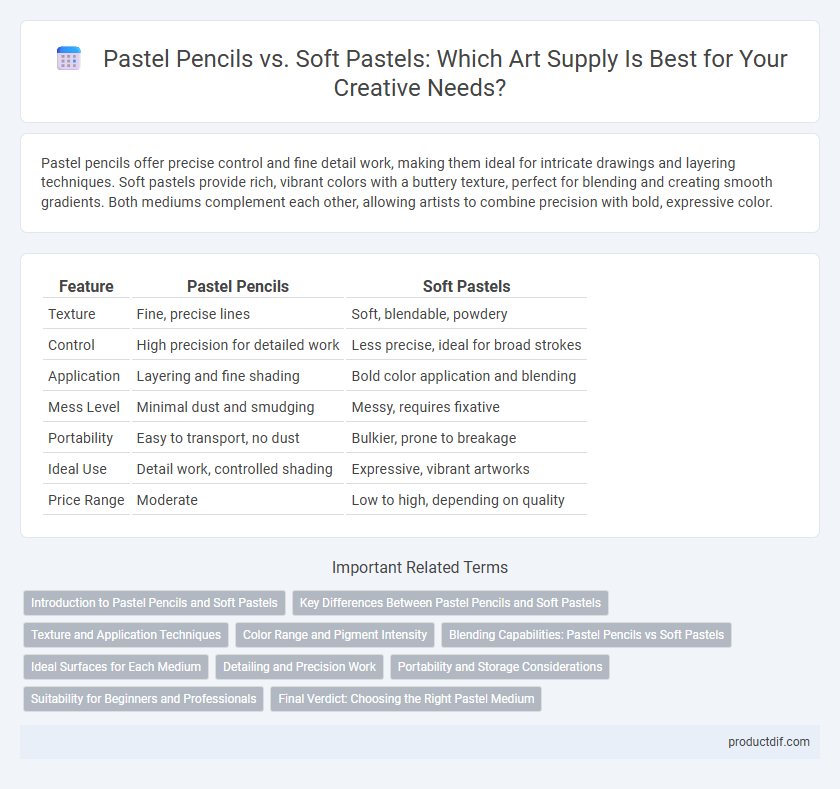Pastel pencils offer precise control and fine detail work, making them ideal for intricate drawings and layering techniques. Soft pastels provide rich, vibrant colors with a buttery texture, perfect for blending and creating smooth gradients. Both mediums complement each other, allowing artists to combine precision with bold, expressive color.
Table of Comparison
| Feature | Pastel Pencils | Soft Pastels |
|---|---|---|
| Texture | Fine, precise lines | Soft, blendable, powdery |
| Control | High precision for detailed work | Less precise, ideal for broad strokes |
| Application | Layering and fine shading | Bold color application and blending |
| Mess Level | Minimal dust and smudging | Messy, requires fixative |
| Portability | Easy to transport, no dust | Bulkier, prone to breakage |
| Ideal Use | Detail work, controlled shading | Expressive, vibrant artworks |
| Price Range | Moderate | Low to high, depending on quality |
Introduction to Pastel Pencils and Soft Pastels
Pastel pencils offer precise control and fine detailing, making them ideal for intricate artwork and layering techniques. Soft pastels feature rich, vibrant pigments with a creamy texture, perfect for creating bold, expressive strokes and smooth color blends. Both mediums require fixatives to preserve artwork and vary in portability, with pastel pencils being more convenient for travel.
Key Differences Between Pastel Pencils and Soft Pastels
Pastel pencils feature a hard, colored core encased in wood, allowing for precise, detailed lines ideal for fine artwork and layering. Soft pastels consist of pure pigment mixed with a minimal binder, resulting in a crumbly texture that produces vibrant, blendable colors suited for expressive, bold strokes. The main differences lie in their application techniques, texture, and color intensity, with pastel pencils offering control and softness delivering rich, painterly effects.
Texture and Application Techniques
Pastel pencils offer precise control and a firm texture ideal for detailed work and fine lines, making them perfect for layering and adding sharp highlights. Soft pastels have a softer, creamier texture that blends easily, allowing for rich, vibrant color application and smooth gradations, often used for expressive, painterly effects. Artists often combine both mediums to utilize the crisp detail of pastel pencils with the lush, velvety finish provided by soft pastels.
Color Range and Pigment Intensity
Pastel pencils offer precise control with a narrower color range and moderate pigment intensity, ideal for detailed work and layering. Soft pastels provide a broader spectrum of vibrant colors and richer pigment intensity, delivering bold, expressive strokes with high coverage. Artists often choose soft pastels for their vivid hues and blending capabilities, while pastel pencils excel in fine lines and subtle color transitions.
Blending Capabilities: Pastel Pencils vs Soft Pastels
Pastel pencils offer precision and control, allowing artists to create fine details but require layering for smooth blending. Soft pastels excel in blending capabilities due to their buttery texture, enabling seamless color transitions and rich gradients. Artists often combine both to balance detailed work with vibrant, smooth blends.
Ideal Surfaces for Each Medium
Pastel pencils perform best on textured paper like sanded pastel paper or watercolor paper, allowing for precise details and control. Soft pastels excel on rough, toothy surfaces such as pastel boards or textured pastel paper, which hold more pigment and enhance vibrant color layering. Selecting the appropriate surface maximizes the unique qualities and blending capabilities of each pastel medium.
Detailing and Precision Work
Pastel pencils offer superior detailing and precision work due to their hard, fine tips that allow artists to create sharp lines and intricate designs. Soft pastels, with their crumbly texture and broader strokes, excel in blending and layering but lack the control needed for fine details. For artwork requiring meticulous accuracy, pastel pencils are the preferred medium, while soft pastels are better suited for expressive, bold applications.
Portability and Storage Considerations
Pastel pencils offer superior portability and easier storage due to their compact, solid pencil form, which reduces the risk of breakage and mess during transport. Soft pastels, while providing richer color and blendability, require careful storage in protective cases to prevent smudging and brittleness. Artists prioritizing convenience and minimal cleanup often prefer pastel pencils for on-the-go use and compact storage solutions.
Suitability for Beginners and Professionals
Pastel pencils offer precise control and are ideal for beginners learning to master fine details and layering techniques, while soft pastels provide vibrant colors and blend easily, favored by professionals for expressive, bold artwork. Beginners benefit from pastel pencils' less messy application and sharpenable tips, enabling gradual skill development. Experts prefer soft pastels for their rich pigment and versatility in creating textures and large-scale pieces.
Final Verdict: Choosing the Right Pastel Medium
Pastel pencils provide precision and control, making them ideal for detailed artwork and fine lines, while soft pastels offer vibrant colors and a rich, blendable texture perfect for expressive, bold strokes. Artists seeking versatility and ease of layering may prefer soft pastels, whereas those prioritizing detail and portability often choose pastel pencils. Selecting the right pastel medium depends on the desired artistic effect, working style, and the level of blending or detail required in the final piece.
Pastel pencils vs Soft pastels Infographic

 productdif.com
productdif.com